Teaching Innovations
College of Fine Arts faculty seek novel and fun ways to boost student learning
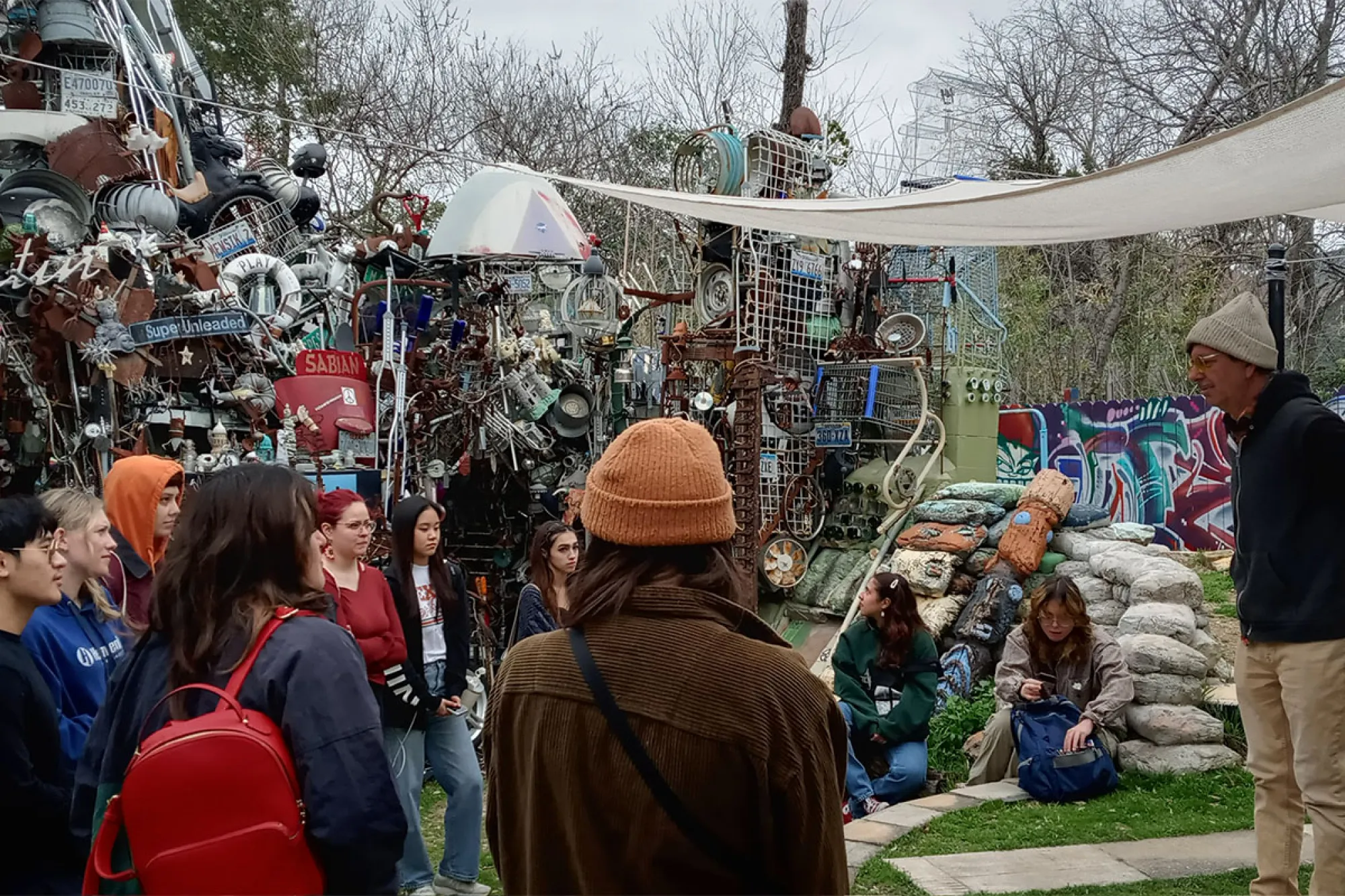
By Alicia Dietrich, Neerul Gupta, Jennifer Irving and Cami Yates
As a college that’s built on hands-on, experiential learning, the College of Fine Arts is full of examples of great teaching. Here, we highlight some recent examples of innovation in the classroom to help students build new skills, execute visually stunning work and learn from their incredible faculty members.
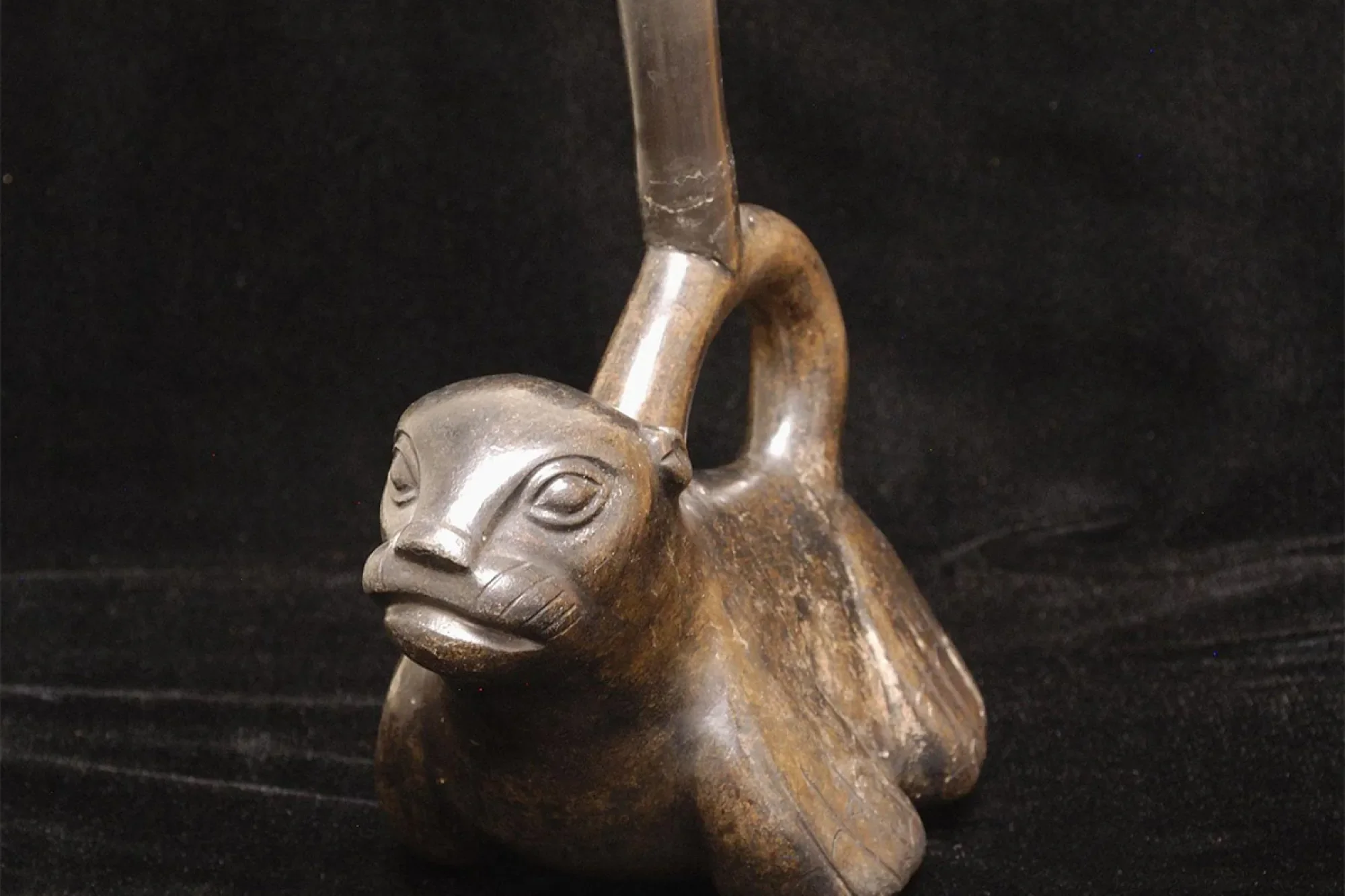
Co-teaching faculty members develop a graduate seminar to push themselves and their students beyond their individual comfort zones
In Spring 2023, two Art History professors teamed up to co-teach a graduate seminar on water histories, a theme that transcends their respective research areas. Professor Ann Reynolds, whose research focus is 20th and 21st-century art and visual culture in the United States and Europe, and Professor Julia Guernsey, whose research is focused on pre-Columbian Mesoamerican art, had discussed a collaborative teaching experience before landing on the right opportunity. As they brainstormed ideas, Reynolds and Guernsey started with the keywords “long” and “deep” histories, looking for a topic that could connect the ancient world with the modern world across cultures. They landed on water as a theme that could encompass both.
“I think both of us are interested in getting into the other’s brain a bit to understand how each other thinks and works,” Guernsey said of the collaboration. “Another goal was to model for the students outside-the-box thinking and collaborating with someone who wouldn’t be necessarily a logical partner. We were also interested in pursuing a topic that we were not experts in, but that we thought would be a really fruitful exploration within the realm of art and art history.”
Both Reynolds and Guernsey use archives and artifacts in their own research, and they wanted to model how to explore history through different types of evidence. So, they focused the first half of the seminar on exploring a wide variety of objects and images to help the students to think visually about water histories. The class, which included students from Art History, Studio Art, the Michener Center for Writers, the School of Information, and Native American and Indigenous Studies, visited multiple libraries and archives on campus, including the Harry Ransom Center and the Benson Latin American Collection.
The class also used the pre-Columbian objects collection in the Department of Art and Art History. Associate Professor of Instruction Astrid Runggaldier, curator of the collection, pulled a selection of objects relating to the water theme, and the class explored questions around how water is visually represented in the objects, which included ceramics and textiles. Reynolds and Guernsey then worked with Runggaldier to curate a selection of these objects for a small exhibition in the dean’s administrative suite.
The students were asked to join one of three working groups focused on cities with long and complex relationships with water (Mexico City, New Orleans and Fukushima); each group selected the reading and viewing assignments and led discussions during the second half of the seminar. Individually, over the course of the semester, the students created an archive of materials — primary and secondary literature, oral histories, their own artistic creations and other works of art, images and literature, music or film — for their own water-related projects, which they then shared with the class at the end of the semester.
— AD

Within Walking Distance: Taking students out of the classroom and into their communities
So much of higher education focuses on classroom learning. For decades large lectures have been the baseline for building knowledge and seeking to comprehend the world around us. But for many in the arts, learning in a classroom can’t measure up to the experience students have when spending time directly in their communities. In Nicolás Dumit Estévez Raful Espejo Ovalles’ experimental class Within Walking Distance, he aims to forgo the classroom almost altogether.
As the Department of Art and Art History’s first social practice artist-in-residence, Estévez primarily was focused on embedding students into different places and spaces around Austin, especially parts of the city that may not be conducive to walking. Estévez took the class to East Austin, where most, including students who were born and raised in Austin, had not spent much time. They visited cemeteries, toured local landmarks, and tried to get “lost” in the grid of city streets. Most importantly, no matter where they went, they kept their eyes up and observed the people and places around them.
“The intention was to walk through layers,” Estévez said. “Cities have so many layers. Most cities do. And the intention of this class was to perhaps access some of these strata and fields that sometimes are not visible to most people.”
Made up of both art students and others from across UT, including business and pre-med majors, the students informed their class walks with Estévez’s detailed readings, which required participants to respond to relevant topics in Austin, including gentrification and historical segregation. Estévez had students respond in a variety of ways: by drawing personal maps, both accurate and imagined; writing poetry; and even creating art about their shoes.
“One prompt would be, for example, ‘How will you take up space in Austin?’ And their map was the journal, the sketchbook,” Estévez said. “How would it look if you could build an additional section to the city? Where is the space in the city where you would feel safe? Can you render that space through drawing?”
Despite exploring spaces unfamiliar to them, Estévez repeatedly heard similar sentiments from students — that the class filled them with an unexplainable sense of peace. By becoming participating, engaged members of their community, students seemed less stressed and anxious. After almost 15 years of hosting this class, Estévez said he still feels fulfilled and excited about helping young people explore their world on foot.
“I had a wonderful time with the group,” Estévez said. “Everybody was present, and everybody attended the classes, did the work, and people really wanted to be there.”
— JI
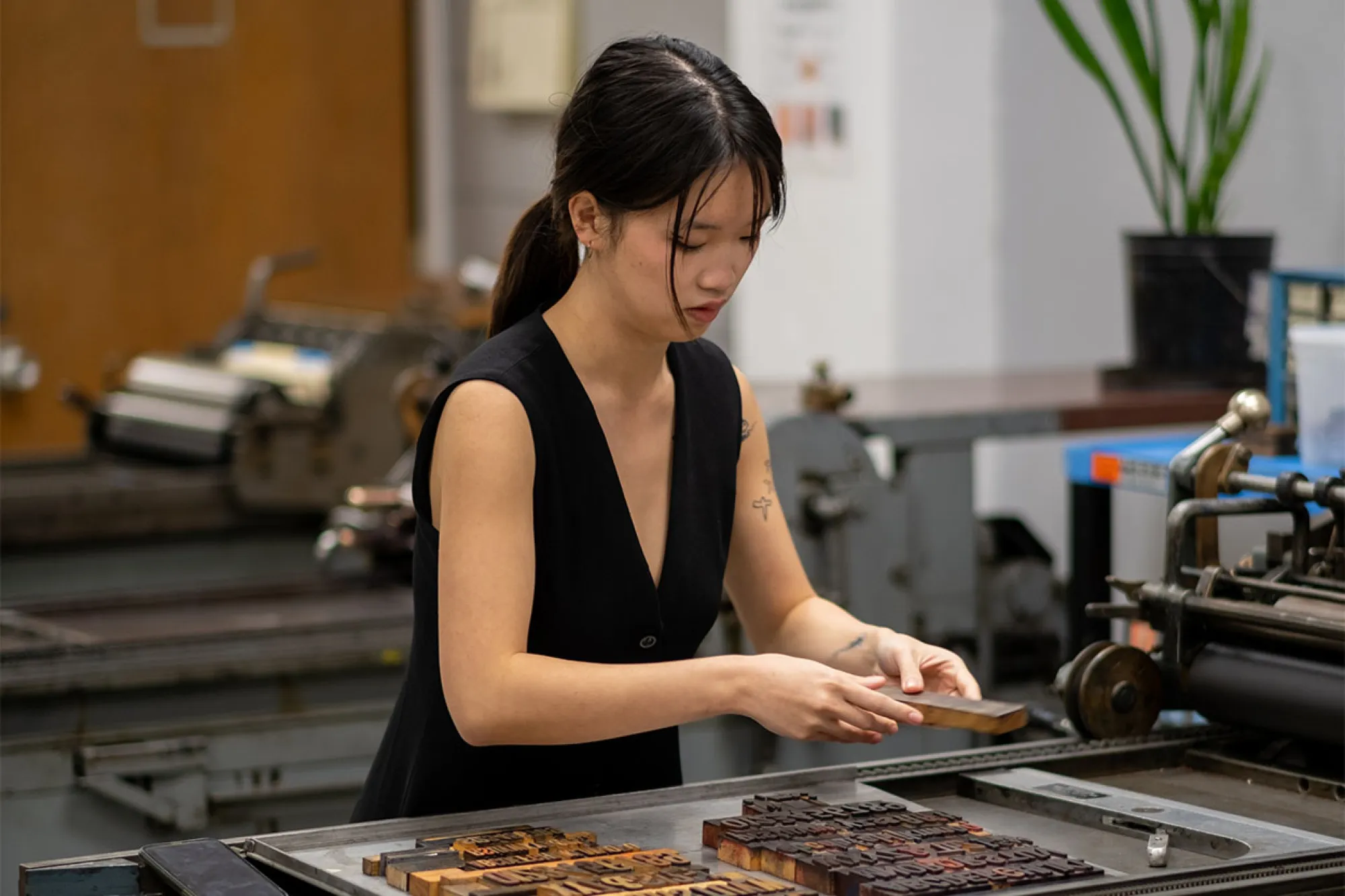
Design students learn about printing history by using Rob Roy Kelly collection
Today, we have the standard office printer. Two centuries ago, we had wood.
Wood type became popular in the 19th century to print large text on posters. Design educator and historian Rob Roy Kelly was the founding scholar of wood type and assembled the Rob Roy Kelly American Wood Type Collection (RRK), a 150-piece assemblage of typefaces he collected from printers in the mid-20th century. The collection is housed in the Department of Design.
Henry Smith, assistant fabrication manager in the School of Design and Creative Technologies, is the custodian of the collection and oversees student use of it. Design students take an introductory typography class to learn how to use the RRK collection, after which they can access the collection for any printing needs.
“I want to get the collection in as many hands as possible,” Smith said. “By including the RRK in our course curriculum, we make it exciting and accessible.”
Design senior Gabby Rivera and design graduate Gabi Williams used the RRK to create signage, promotional merchandise and professional assignments. Rivera practiced making a radial gradient with the collection, and Williams created a bumper sticker for her social media role at UT’s student radio station, KVRX.
“I spend a lot of time creating in the digital world, so using the RRK can be challenging,” Rivera said. “But bringing my work into the physical world has been rewarding.”
Smith is working to expand access to the collection for more students outside the classroom through paid extracurricular student opportunities.
“These are artifacts, but it’s not useful for them to live in a glass case,” Smith said. “The best way to care for and respect the RRK is to use it respectfully. Then, history lives on.”
— NG
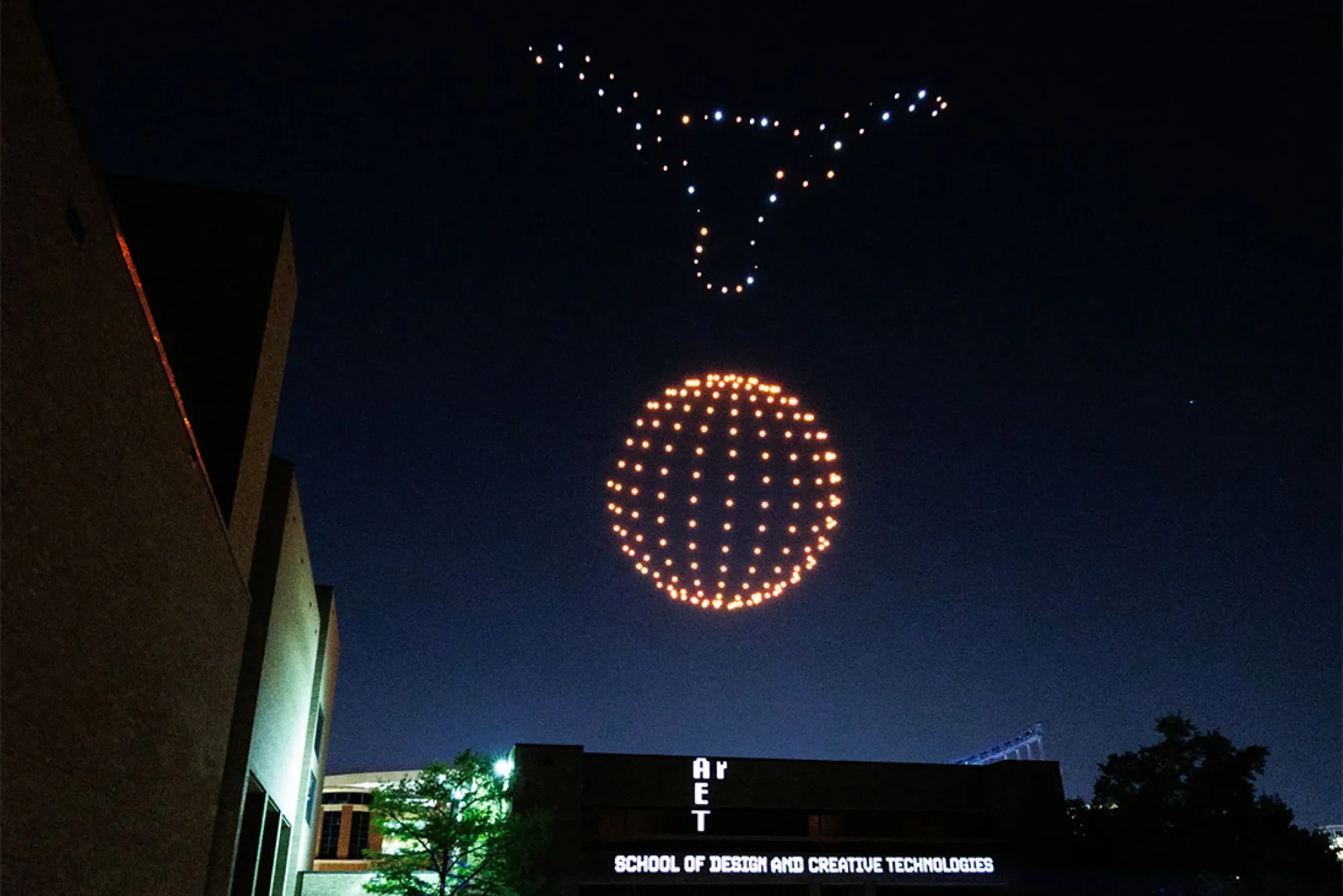
Arts and Entertainment Technologies class creates stunning drone show and projection project to showcase skills
Arts and Entertainment Technologies soared to new heights in 2024 with a breathtaking showcase featuring a student-produced drone show with stunning projection mapping on the Doty Fine Arts Building façade as part of the School of Design and Creative Technologies’ “Inside Out” showcase. Assistant Professor of Practice Matt Smith led a 3D projection mapping class, which created the overall design and execution of the projection and drone performance. Students in this class worked extensively with Adobe Creative Suite, Green Hippo Media Server and Verge Aero drone software, building content around the showcase’s “Inside Out” theme. The drone show showcased colorful imagery, including a Longhorn and the UT Tower.
The class of 15 students was divided into four teams: Three teams focused on the projection content (images, textures and text), and a fourth team focused on drone programming. Over three weeks, they collaboratively developed and implemented the show elements. Previsualization software was used for drone components, while projection content was previewed using a scale model of the Doty Fine Arts Building.
— CY
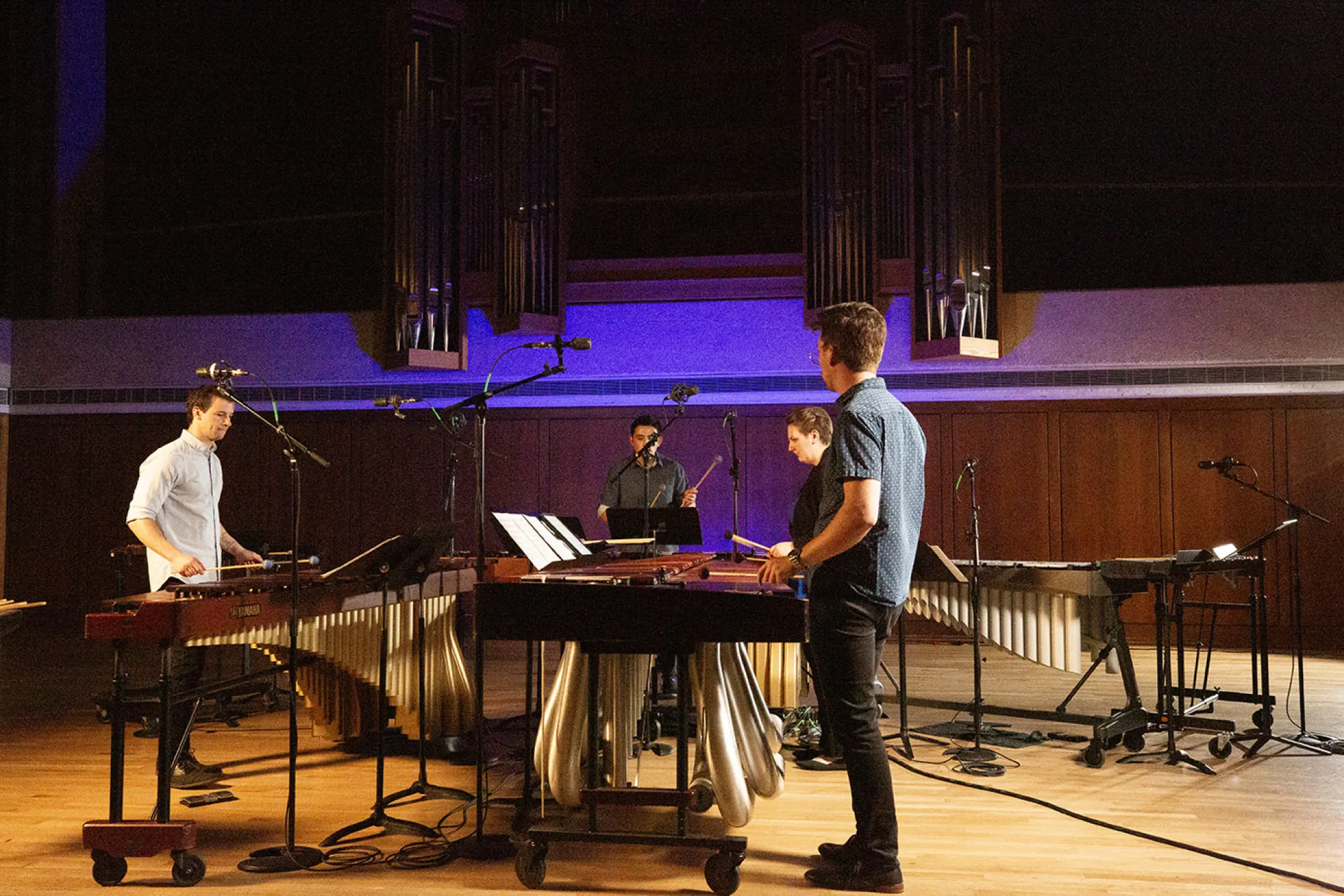
Percussion Ensemble composition project helps students grow as musicians
During the fall, the UT Percussion Ensemble experimented with a new kind of concert. Led by Assistant Professor of Practice Ivan Trevino, the ensemble composed, arranged and performed an entire concert of original music. The performance, titled Music by Us, was such a success that the ensemble received funding from the Rainwater endowment in the Butler School of Music to create audio and video recordings of their work in April.
“As a composer, performing my own music allows me to connect with listeners in a personal way. To be able to speak about a piece, why I wrote it — it helps create a sense of community with listeners. Music by Us offered our students this same creative platform, and it also created a feeling of togetherness within our studio. It’s special to workshop and perform a piece created by someone you know, someone you go to class with and see every day. Through all of the music growth, Music by Us turned into a great team-building experience that brought our studio members closer together.”
The concert included music by seven students who composed or arranged works for more than 20 performers in genres ranging from pop music to rock music. The students plan to share the video recordings online and maybe even record an album of their works someday.
“We’re letting people know that you have permission to do this,” Trevino said. “Creating music can be part of your experience here at the Butler School of Music.”
— AD

